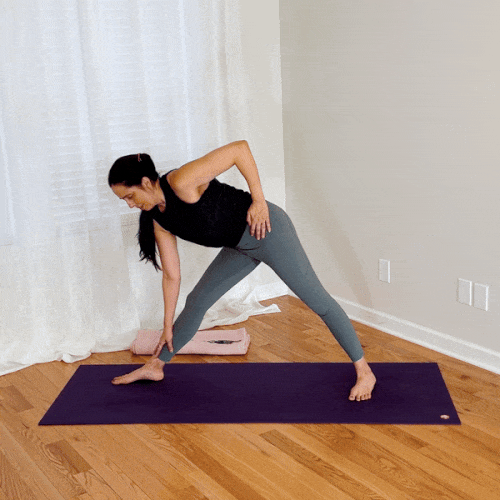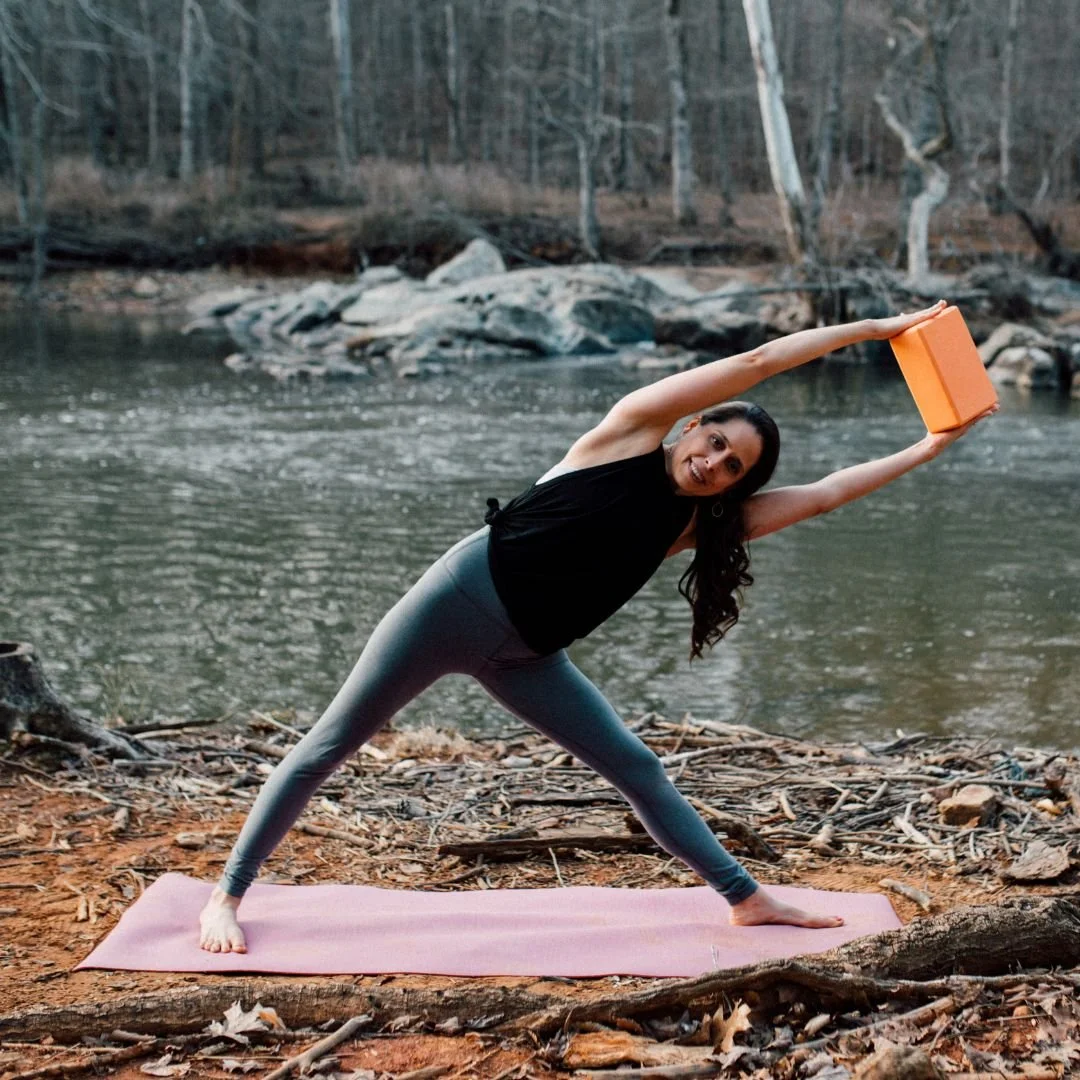Triangle Pose: Stay Within Two Panes of Glass?
This blog post was first sent to Jenni’s email list as an email newsletter. Sign up for the JRY email newsletter here!
The “two panes of glass” cue in triangle pose (trikonasana) might be one of the most controversial yoga cues out there. Have you noticed?
Some schools of yoga happily teach this cue, using it to encourage students to align their body in the anatomical “frontal plane“ of movement in triangle pose. (That’s the plane of movement in which our movements are lateral, or side-to-side in nature.)
On the flip side, other schools of yoga teach that this cue is inherently dangerous and should be removed from our yoga teaching lexicon.
In my experience, this latter approach has grown more popular in recent years.
To illustrate, a quick Google search for “two panes of glass in triangle pose” pulls up these top listings:
an article stating that “[Triangle] pose used to be taught with the instruction of 'imagine you're between two panes of glass' to encourage people to keep both hips in a line. However this can put strain on the lower back in the SI joint. Instead, when folding towards your left foot, allow the right hip to roll forward.”
a YouTube video titled “Can we shatter those ‘panes of glass’ in triangle pose?”
a Yoga Journal article that claims, “The consequences of contorting the pelvis into the ‘glass hallway’ by pulling the back pelvis open can cause the front knee to collapse inwardly, straining the inner knee ligaments over time... Positioning the pelvis in this manner also destabilizes the head of the thigh bone in the hip socket.”
As you can see, there are many strong opinions in the yoga world that the “two panes of glass” cue is harmful and shouldn’t be taught.
So… what’s the right approach in triangle pose? “Two panes of glass”: yay or nay?
In this article, I’ll demonstrate that the cautions about the injurious nature of “two panes of glass” don’t hold up to biomechanical scrutiny.
We can use this cue if we like it, or we can skip it if we don’t like it. But there’s no need to go out of our way to avoid it out of beliefs that it’s injurious.
In short, you can use this cue and still be a good yoga teacher – I promise! ;)
Quick review: why does the “two panes of glass” cue exist in the first place?
Triangle is a side-facing yoga pose in which our body orients toward one side of our yoga mat.
However, it’s common to see yoga students who are new to this pose not quite achieve this laterally-oriented alignment.
Instead of orienting their whole body toward the side wall, students often turn one or more areas of their body downward, toward the floor.
One example we often see is a yoga student turning their torso to face in a more downward than lateral direction, like this:
Triangle pose with the torso rotating toward the floor
Another common example (and the one that the “two panes of glass” controversy surrounds!) is when a yoga student rotates their pelvis toward the floor rather than toward the side wall, like this:
Triangle pose with the top hip rolling down
(This pelvis example is also often described as “rolling the top hip toward the floor.”)
Because triangle pose is intended to be a frontal plane pose, yoga teachers sometimes use the instruction to align one’s body “between two panes of glass” to help counter either or both of these tendencies.
The intention of the cue is to encourage the body to align in a laterally-oriented direction.
So that’s the gist of where this cue comes from and what it’s about.
Now… why all the fuss around this cue? Why do we hear claims that this instruction is harmful and should be abandoned?
First important point: aligning between two panes of glass in triangle isn’t even anatomically possible for most people.
Most people don’t have the hip range of motion to totally, completely, 100% align their pelvis towards the side wall while simultaneously pointing their front foot straight towards the front of their yoga mat. This is the reality of the structure of the hip joint.
Technically, it would take 90° of external rotation in the front hip joint to fully “square” one’s pelvis to the side while pointing the front foot straight forward. According to normative data, that’s about 45° more external rotation than most people have!
Given this anatomical reality, most people will naturally roll their top hip downward in triangle pose.
This (usually unconscious) adjustment reduces the amount of rotation in the bottom hip, and it allows us to maintain the classic triangle position of pointing our front foot straight forward.
I explain this aspect of triangle pose with my collaborator Travis Pollen, PhD, in this short YouTube video – check it out for our visual demonstration!
(BTW, Travis is an exercise science professor and expert on injury prevention research. I’m sure you’ll appreciate what he has to say in this video about the injury risk — or lack thereof ;) — involved in “two panes of glass”!)
It’s a given that we can’t literally align “between two panes of glass.” But… is it injurious to try?
In my experience, the criticism of the “two panes of glass” cue goes something like this:
We can’t embody that complete side-facing alignment.
Therefore, attempting to embody it is dangerous, and we shouldn’t try. So “two panes of glass” should be stricken from all yoga teaching language about triangle pose.
Now I’m definitely on board with point #1, but I stop short of jumping to the conclusion of point #2, because there’s simply no biomechanical support for that claim.
It’s true that our hip external rotation range of motion probably won’t allow us to literally align our hips “between two panes of glass.”
No matter how hard most of us try, we’ll simply be unable to orient our entire body to face sideways in this pose. This is true!
However, despite popular claims and cautions, it is not possible for us to injure ourselves by trying to rotate our hips into this “stacked” or “squared” position in triangle pose.
This is because in attempting to move closer to this alignment, we are actively using our hip muscles.
Just picture it: suppose our top hip is rolled down toward the floor a bit. If we try to counteract that by rolling that top hip back, we create this action by actively contracting the hip rotator muscles of our bottom hip.
When we actively use our muscles, we can never pull ourselves into our true end-range position (i.e., the position in which we’d potentially be more vulnerable to injury) – because we always have more passive range of motion available in our joints than active range of motion.
An active range of motion version of pigeon pose
Active vs. passive range of motion
You might’ve tuned into the narrative about active vs. passive range of motion that’s grown in popularity in the yoga world in recent years.
There are widespread claims that when we embody our yoga poses with active muscles, we are “safe” and “protected” from injury. And when we “hang out passively” in our yoga poses, we’re told this is unsafe and injurious.
This is actually a complex and nuanced topic that’s oversimplified in these “active is good; passive is bad” statements we so often hear.
If you’re interested in a deeper dive into the science of active vs. passive muscles in end-range training, Travis and I wrote an in-depth article on this topic here: End-Range Training: Does Closing the Gap Between Active and Passive ROM Prevent Injuries?
Suffice it to say, when we use our muscles actively to move us into a position, we can never reach our full end-range joint position due to “the gap” between active and passive range of motion.
Therefore, in triangle pose, if we actively externally rotate our bottom hip to rotate our pelvis into more of a “stacked” position (it won’t be completely stacked, of course, but it will be more stacked than it was), we can’t harm ourselves. All we’re doing is activating our hip rotator muscles in a shortened position.
This simply isn’t an injurious anatomical action!
PNF, PAILs/RAILs, and end-range training in the yoga world
Just think about it: bringing a joint into its end range and then actively contracting the muscles of that joint is actually a popular practice these days in the yoga, fitness, and rehab worlds.
You might know this approach by the name PNF (proprioceptive neuromuscular facilitation) or by the acronyms PAILs/RAILs (progressive/regressive angular isometric loading), coined by the Functional Range Conditioning (FRC) training system.
Activating our muscles in end-range positions is a nice strategy for building end-range strength and increasing flexibility. It’s not harmful for us or injurious – it’s helpful for us!
“Stacking the hips” in triangle pose isn’t quite “end-range training,” but…
Triangle pose with top hip rolled back (hand on hip for visual emphasis)
Now when we work to “stack the hips” toward the “two panes of glass” ideal in triangle, we don’t generally perform this action with the same intensity and duration that people typically do when they perform techniques like PNF or PAILs/RAILs.
Therefore, I wouldn’t call stacking the hips in triangle pose true end-range training – it’s more of a yoga alignment adjustment.
But it is an action in which we work the muscles on the shortened side of the hip joint to pull the hip further into that range of motion. So hopefully you can see this is basically just a low-level version of an end-range training technique.
If techniques like PNF and RAILs are safe and beneficial for us, how could rolling the top hip back in triangle pose be bad for us – especially when it’s performed at a lower intensity and duration than these techniques anyway?
Side note: just for the record, we can work with these end-range training techniques by targeting the muscles on the shortened or lengthened side of a joint.
But in this blog post, we’re focusing on movements that target the shortened side of the joint. That’s what we do when we attempt to align our hips “between two panes of glass” in triangle pose.
Common examples of contracting muscles in shortened positions in yoga:
Prone Y’s
In this move – regularly taught in yoga, fitness, and rehab settings across the globe! – we lie face down with our arms in an overhead “Y” position.
Here, our shoulder muscles are in a shortened position. (Just like the hip rotator muscles in triangle pose are!) Then we contract these shortened muscles, training them in their end range, as we lift our arms up and over the yoga blocks.
Prone Y’s
Straight-Leg Fire Hydrants
In this move, we start in a hands-and-knees position and step one leg out to the side, into horizontal abduction.
This places our lateral hip muscles in a shortened position. And then we contract these shortened hip muscles to lift our straight leg up to hover over the yoga block.
Straight-leg fire hydrant
So both the straight-leg fire hydrant and triangle pose target the hip in an end-range position by contracting the lateral hip muscles in their shortened position. But for some reason straight-leg fire hydrants are just fine, while rolling the hip back in triangle pose will damage us? How does this compute?? :) )
Ardha Hanumanasana (Half Split) Leg Lifts
I know it’s a bit tricky to see here :), but my front foot is hovering off the floor in this photo.
I’ve come into my half-split position, which puts the hip flexors of my front leg in a shortened position, and then I contract those shortened hip flexors to lift my leg off the floor.
This is yet another great example of end-range training!
Ardha hanumanasana (half split) leg lifts
After looking at these other examples of active muscle contractions in shortened positions, we see they’re all A-okay and nothing to fearmonger about :). Let’s now revisit the controversial “two panes of glass” movement in triangle pose that we’re told is so harmful for us.
Here’s what it looks like when we rotate our pelvis from turning downward to facing more toward the side. (My top hand is on my hip just to help make the movement more noticeable.)
Aligning the hips “within two panes of glass” in triangle pose
Hopefully, your movement eyes can see this is simply another form of short-range muscle contraction. It’s just like all those other examples many of us do all the time that we have no reason to worry about!
An important exception
Clearly, attempting to square our hips in triangle pose is not an injurious undertaking – and it could in fact be beneficial, if a little bit of short-range training is our goal in the moment.
But there are exceptions to every rule. It’s important to point out that if a yoga teacher were to give a student a forceful, fast, physical adjustment to try to push their body into a “two panes of glass” alignment, this would not be A-okay and could be injurious.
This is an example in which attempting to square the hips in triangle could actually be injurious. But it involves external force from another person, and that force would need to be high and fast to potentially cause damage.
But if we’re in our triangle pose and we’re attempting to roll our own hip back a bit using our own hip rotator muscles? There’s no reason to worry about a movement like this. We can all breathe a sigh of relief – thankfully!
So should we all start cueing “two panes of glass” in triangle pose?
If you’ve followed my work at all, you probably know I don’t generally prescribe black-and-white rules when it comes to movement (e.g., “Everyone should use this cue!” or “No one should ever use this cue!”). The science typically suggests a more nuanced, “it depends” approach.
The truth is that when it comes to the “two panes of glass” cue, I’m not sure if I’ve ever personally used this cue myself in any of my yoga classes!
So I’m certainly not suggesting that we should all go out and start using this cue every time we teach triangle pose. :) Not at all!
But I am suggesting that despite popular claims – on Google, in yoga teacher trainings, in yoga books, etc. – the “two panes of glass” cue is not a terrible, harmful cue. And you aren’t the worst yoga teacher in the world if you use it! (Haha, I’m exaggerating, of course, but this really is the attitude I see surrounding this benign little cue!)
Bottom line: you should use the cues that resonate with you and your students. It’s as simple as that!
There are multiple ways to describe any movement. And there are also a wide variety of intentions we might have for any yoga pose we teach in the moment – including triangle pose!
If your students seem to be having a tough time embodying their triangle poses in a generally side-facing alignment, and if this alignment is important to you, then using the “two panes of glass” cue can be helpful! All this cue is asking is for a yoga student to roughly align their body in the frontal plane.
But if you don’t resonate with this cue – and many yoga teachers don’t! – you could say the same thing with different words. Perhaps you prefer, “Pretend that your body was lined up against a wall,” or “Turn your body to face the side wall,” or something else entirely!
As we discussed, most people can’t literally align their entire body in a “two panes of glass” manner. And that’s fine! Many of our other yoga cues aren’t meant to be taken literally either. They’re just ideas, suggestions, or metaphors to help encourage the general arc of a movement.
And even if an enterprising yoga student did decide to try to literally align all of their body parts in a side-facing orientation, including attempting to “square” their pelvis to the side, this would also be fine. We know they’re not going to harm themselves by doing this. If anything, they might benefit from a little extra short-range hip rotator work!
Ending with the bigger picture
Let’s end by taking a step back from the minutiae of this triangle pose cue and considering our approach to yoga cueing in general.
We know from research that yoga is not an injurious movement practice, relatively speaking. Yoga is a slow-paced, low-load movement practice that’s generally quite safe.
When injuries do happen in yoga, they’re a result of a complex mix of factors across multiple domains (biological, psychological, and social). Our alignment in a specific yoga pose is unlikely to cause an injury in isolation.
With this in mind, we should question the common claims we hear in the yoga world that the smallest changes in our alignment can have detrimental and injurious effects on our body.
If actively rotating our hips in triangle pose a few degrees in one direction was really the cause of widespread low back, SI joint, knee, and hip injuries, we’d have a lot more to worry about in our lives than little old triangle pose!
Luckily, we aren’t inherently fragile beings, destined for injury and damage from the slightest change of position in a yoga pose.
On the contrary, we’re inherently robust and resilient beings, and our movement practice only helps make us more robust and resilient.
So let’s set a positive example in our yoga community by refraining from spreading fear and worry about innocent cues in benign yoga poses!













